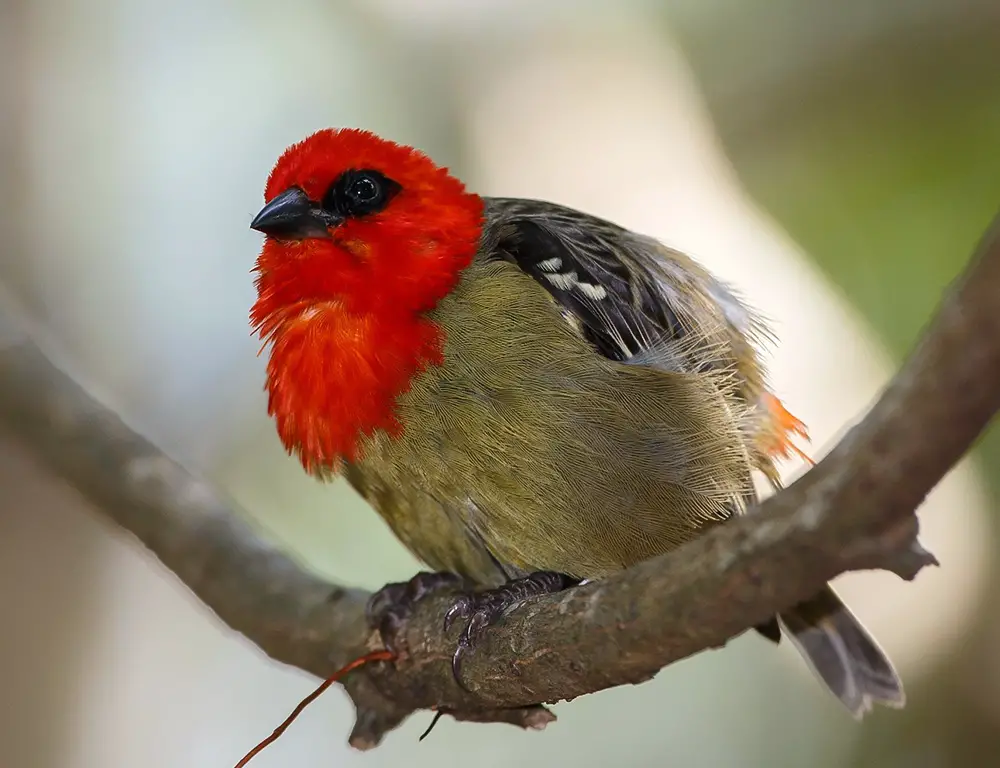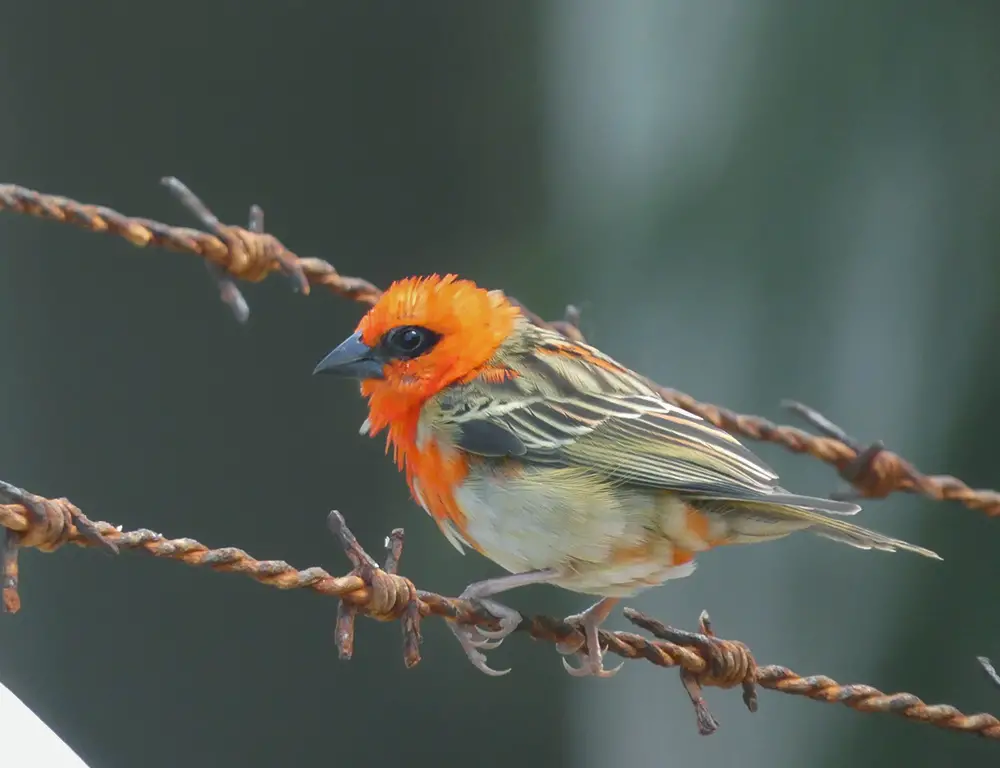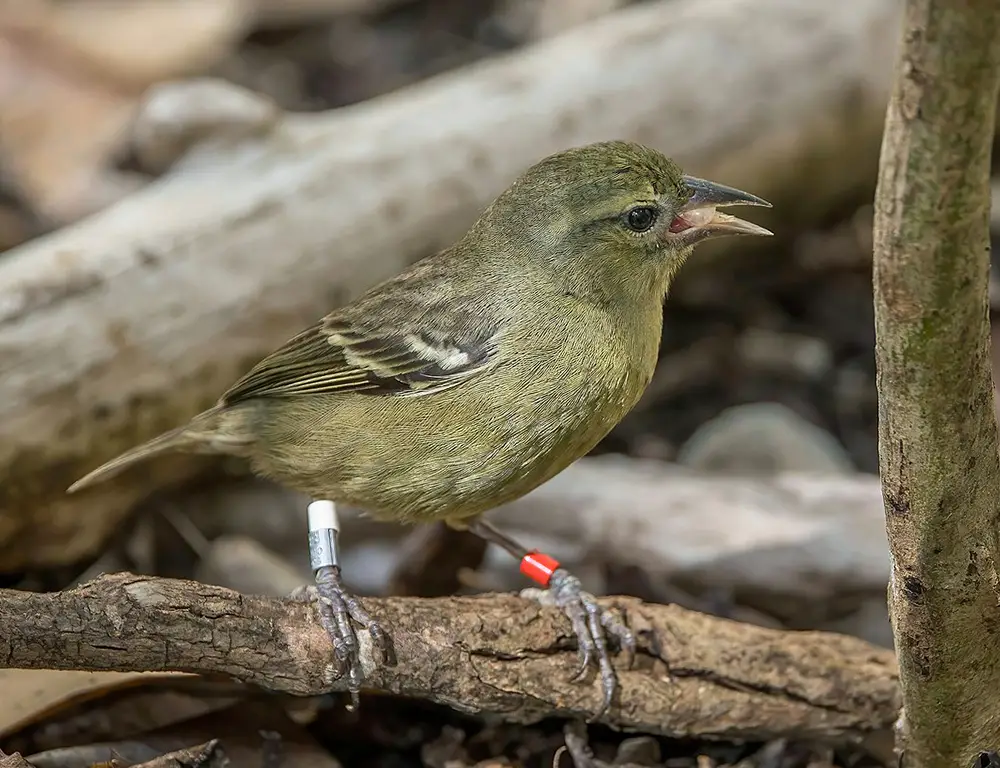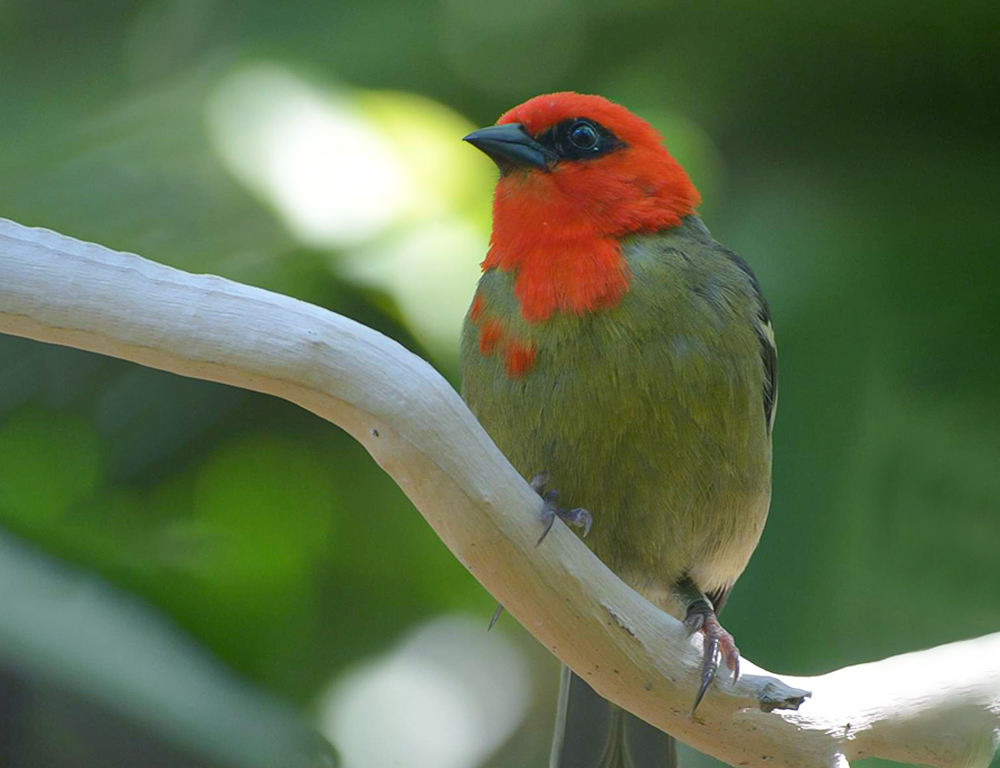The Mauritius Fody (Foudia rubra) stands as a vibrant emblem of the island of Mauritius, captivating enthusiasts with its striking appearance and unique ecological niche.
Endemic to this idyllic paradise, the Fody is a small passerine bird renowned for its captivating plumage and intricate behaviors.
During the breeding season, males don a fiery ensemble of red feathers, contrasting starkly against the lush greenery of their habitat.
In contrast, females maintain a more understated olive-brown hue year-round. Despite its diminutive size, this avian marvel plays a significant role in the island’s ecosystem dynamics, foraging the shrubby vegetation for insects, berries, and nectar.
However, the species faces mounting threats, including habitat loss and predation by introduced species, underscoring the urgent need for conservation efforts to safeguard its future.

Physical Characteristics of Mauritius Fody
The Mauritius Fody (Foudia rubra) is a captivating bird species endemic to Mauritius, possessing distinctive physical characteristics contributing to its unique appearance. Here’s an overview:
Size
The Mauritius Fody is relatively small, measuring approximately 14 centimeters (5.5 inches) in length. Despite its diminutive stature, this bird exudes a remarkable presence in its natural habitat.
Plumage
One of the most striking features of the Mauritius Fody is its plumage, which exhibits notable sexual dimorphism.
Breeding males showcase a dazzling display of colors, with olive-brown plumage accentuated by vibrant red patches on the head, breast, and rump.
These fiery hues contrast sharply against the bird’s darker wing and tail feathers. In contrast, females and non-breeding individuals maintain a more subdued appearance, with olive-brown plumage dominating their overall coloration.
The distinct coloration of breeding males serves multiple purposes, including mate attraction and territorial displays.
Facial Features
Breeding males of the Mauritius Fody often sport black lores, the areas between the eyes and the bill. This feature adds depth and contrast to the bird’s facial appearance, enhancing its visual appeal.
Wing Bars
Both male and female Mauritius Fodies may exhibit white wing bars, adding subtle yet elegant accents to their plumage. These wing bars are particularly noticeable during flight or when the bird is perched, providing additional visual interest.
Bill
The bill of the Mauritius Fody is typically slender and pointed, adapted for feeding on a varied diet that includes insects, berries, and nectar. This versatile bill structure allows the bird to exploit various food resources within its habitat.
Habitat and Distribution of Mauritius Fody

The Mauritius Fody (Foudia rubra) is an endemic bird species found exclusively on the island of Mauritius in the Indian Ocean. Its habitat and distribution are closely tied to the unique ecological conditions of this island. Here’s an overview:
Native Habitat
The Mauritius Fody inhabits various forested and semi-forested habitats across Mauritius, including upland forests, scrublands, and degraded areas.
These habitats typically feature dense vegetation, providing the Fody ample cover for foraging, nesting, and seeking refuge from predators.
Altitudinal Range
While the Mauritius Fody can be found at various altitudes across the island, it favors areas above 300 meters. These higher elevations offer suitable conditions for the bird’s preferred vegetation and food sources.
Preferred Vegetation
Within its native habitat, the Mauritius Fody is often associated with shrubby vegetation, where it can find an abundance of insects, berries, and nectar.
The bird’s adaptability allows it to utilize a range of plant species for feeding and nesting, including native and introduced vegetation.
Distribution
Historically, the Mauritius Fody was more widespread across Mauritius, occupying a range of habitats throughout the island. However, extensive deforestation and habitat loss have resulted in a contraction of its distribution.
Today, the species is primarily restricted to remaining patches of suitable habitat, with populations concentrated in protected areas such as the Black River Gorges National Park.
Behavior and Diet of Mauritius Fody

The behavior and diet of the Mauritius Fody (Foudia rubra) are fascinating aspects of its ecology, offering insights into its unique adaptations and role within its native habitat.
Here’s an exploration of the behavior and diet of the Mauritius Fody:
Foraging Behavior
The Mauritius Fody is primarily arboreal, spending much of its time foraging for food among the vegetation of its habitat. It is agile and adept at maneuvering through dense foliage for prey items.
Diet
The diet of the Mauritius Fody is diverse and includes various food items. Its primary food sources consist of insects such as grasshoppers, beetles, caterpillars, and spiders, which it captures by gleaning from leaves and branches.
Additionally, the Fody feeds on berries, fruits, and seeds when available.
Nectar Feeding
One exciting aspect of the Mauritius Fody’s diet is its nectar consumption. Its specialized brush-tipped tongue allows it to extract nectar from flowers.
This adaptation enables the Fody to exploit floral resources within its habitat, supplementing its insect-based diet with sugary nectar.
Breeding Behavior
During the breeding season, typically from September to January, the Mauritius Fody undergoes behavioral changes associated with courtship, nest building, and rearing offspring.
Breeding pairs engage in elaborate courtship displays, and both parents participate in constructing intricate woven nests made of grass, moss, and other plant materials.
Social Behavior
Mauritius Fodies are typically observed in pairs or small groups, although they may also form larger flocks, especially outside the breeding season. Within these social groups, they engage in various behaviors such as foraging, preening, and vocalizations.
Breeding males may exhibit territorial behavior, defending their nesting sites and engaging in vocal displays to attract mates.
Nesting Behavior
The Mauritius Fody is known for its skillful nest-building abilities. Breeding pairs construct domed nests with side entrances, often suspended from branches or hidden within dense vegetation.
These nests protect from predators and the elements, ensuring the survival of their offspring.
Conservation Status of Mauritius Fody

The conservation status of the Mauritius Fody (Foudia rubra) is a matter of significant concern due to its classification as an endangered species. Here’s an overview of its conservation status and the threats it faces:
Endangered Status
The Mauritius Fody is classified as endangered by the International Union for Conservation of Nature (IUCN) Red List.
This designation is based on a significant decline in population size and range, primarily attributed to habitat loss, predation by introduced species, and other anthropogenic threats.
Habitat Loss
One of the primary threats to the Mauritius Fody is habitat loss and degradation. Deforestation, urbanization, and agricultural expansion have resulted in the loss of native vegetation and fragmentation of its habitat.
This loss of suitable habitat reduces the availability of food sources, nesting sites, and shelter, negatively impacting the species’ survival.
Predation by Introduced Species
The introduction of non-native predators, such as black rats (Rattus rattus) and crab-eating macaques (Macaca fascicularis), poses a significant threat to the Mauritius Fody.
These predators prey on eggs, chicks, and adult birds, leading to increased mortality rates and reduced reproductive success.
Nest Predation
In addition to predation by introduced species, the Mauritius Fody faces nest predation by common mynas (Acridotheres tristis), which compete for nesting sites and may destroy eggs or kill nestlings.
Disease
Infestations by tropical nest fly larvae (Philornis downsi) have also been documented as a threat to the Mauritius Fody. Larvae infest birds’ nests, causing nestling mortality and reducing reproductive success.
Conservation Efforts
Despite these threats, concerted conservation efforts are underway to protect and restore the habitat of the Mauritius Fody.
These efforts include habitat restoration projects, predator control measures, captive breeding and reintroduction programs, public awareness campaigns, and research initiatives to understand the species’ ecology and behavior.
FAQs
How does the Mauritius Fody contribute to its ecosystem?
The Mauritius Fody plays a vital role in its ecosystem by regulating insect populations, dispersing seeds, and pollinating flowers while foraging for nectar.
What is the lifespan of a Mauritius Fody?
The average lifespan of a Mauritius Fody in the wild is estimated to be around 4 to 5 years, although some individuals may live longer in favorable conditions.
How do Mauritius Fodies communicate?
Mauritius Fodies communicate through various vocalizations, including chirps, trills, and songs. These vocalizations are used for territory defense, mate attraction, and social interactions within their groups.
Are there any cultural or symbolic meanings associated with the Mauritius Fody?
The Mauritius Fody holds cultural significance as a symbol of Mauritius’s unique biodiversity and is featured in local artwork, literature, and folklore. Additionally, its conservation status underscores the importance of protecting Mauritius’s natural heritage.
How do Mauritius Fodies adapt to changes in their environment?
Mauritius Fodies demonstrate remarkable adaptability to changes in their environment by utilizing a variety of habitats and food sources.
However, rapid environmental changes, such as habitat loss and the introduction of invasive species, pose significant challenges to their long-term survival.
To Recap
The Mauritius Fody (Foudia rubra) is a poignant reminder of the delicate balance between nature and human intervention.
Its vibrant plumage and unique behaviors have captivated researchers and conservationists, highlighting the importance of preserving Mauritius’s rich biodiversity.
However, the Fody faces formidable challenges, including habitat loss, predation by introduced species, and dwindling population numbers. Despite these threats, concerted conservation efforts offer hope for the species’ survival.
We can work towards securing a brighter future for the Mauritius Fody and other endemic species through habitat restoration, predator control, and public awareness initiatives.
By recognizing the value of these iconic birds and the ecosystems they inhabit, we take a crucial step toward ensuring the continued existence of Mauritius’s natural heritage for generations to come.